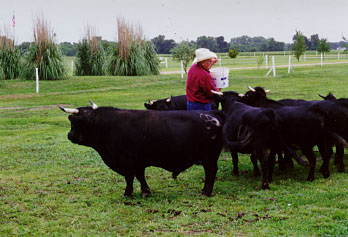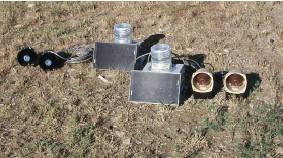The
Ranchers
 Ever since Americans moved to the West and began raising cattle,
there has been a negative attitude against the Mexican wolf amongst
Americans. Before much information had been obtained about wolves in general,
many had already formulated opinions about them. Some of these views
stem as far back as the middle ages, where animals that did not serve mankind,
like the wolf, were seen as "stenchy beasts" that had an inherent right
to be killed. In general, people have viewed wolves for centuries as harmful,
evil creatures who take pleasure out of killing calves, cows and even
humans, even though to this day there has been no record of a person
killed by a wolf (Lopez). Lack of information mixed with fear and a human
knack for exaggeration prompted these preconceptions, and
, in the early 1900's
, were successful in convincing the Federal Government to fund the
complete extermination of the Mexican wolf in the Southwest. In 1914-5,
$125,000 was placed within the program's budget and 300 hunters were
hired for its completion (Brown, 52).
Ever since Americans moved to the West and began raising cattle,
there has been a negative attitude against the Mexican wolf amongst
Americans. Before much information had been obtained about wolves in general,
many had already formulated opinions about them. Some of these views
stem as far back as the middle ages, where animals that did not serve mankind,
like the wolf, were seen as "stenchy beasts" that had an inherent right
to be killed. In general, people have viewed wolves for centuries as harmful,
evil creatures who take pleasure out of killing calves, cows and even
humans, even though to this day there has been no record of a person
killed by a wolf (Lopez). Lack of information mixed with fear and a human
knack for exaggeration prompted these preconceptions, and
, in the early 1900's
, were successful in convincing the Federal Government to fund the
complete extermination of the Mexican wolf in the Southwest. In 1914-5,
$125,000 was placed within the program's budget and 300 hunters were
hired for its completion (Brown, 52).
Currently, more than thirty years since the end of the wolf eradication
program, there continues to exist a voiced opposition from the ranchers
against wolves. Even before the FEIS on the Mexican wolf project was
issued, the Arizona Department of Game and Fish conducted a preprogram
survey to assess the opinions of the different stakeholders. Out of all
the groups asked to participate, ranchers were the only ones who refused
to participate in the survey (Johnson). One of the reasons why ranchers
still oppose the wolf is that they believe wolves will have a considerable
negative impact on their business. During the Mexican Wolf Reintroduction
Program Three-Year Review Workshop (3YRW), Jason Dobrinski,
representing the Grant County Area Cattle Growers Association, criticized
USFWS's attempt to expand the recovery area into New Mexico. Dobrinski
stated that the Cattle Grower's Association did not approve of the expansion
for several reasons. In general, the presence of wolves near private
lands would create additional difficulties for the ranchers. First of
all, wolf predation on cattle would decrease the ranchers ' profits.
This fact was supported by two ranchers from Montana, who spoke at the
plenary discussion to this workshop, who said that the establishment
of wolves in Yellowstone National park had caused their cattle loss to
predators to increase from 3-4% to 5-10% annually. Another difficulty
mentioned by Dobrinsky was that
the possibility of wolves denning on private land would not only increase
federal government interference with the ranchers, but would also demand
ranchers to be more cautious on their own property
(105-6, 128).
The Arizona Cattle Growers Association also opposes
the reintroduction of the Mexican wolf, and generally does not see the project
succeeding in the future. They feel that the wolves' natural prey
base is decreasing, and that the captive bred wolves that are being released
are not suitable for the wild ("Wolf Position").
Despite the majority anti-wolf attitude within
the rancher community, there does exists some support for wolves amongst
the ranchers. Jim Winder of Deming, N.M. is one such supporter. A
member of the executive committee of a local Sierra Club, he had about
200 cows near the White Sands Area in 1996, and in that last decade
had only experienced two wolf depredations on his cattle. He continues
to be a full supporter of the reintroduction program, and believes that
ranchers who learn to harmonize with wolves will be able to create
an even more favorable market for beef than those ranchers who did choose
not to deal with such predators (Davis).
 The idea of ranchers harmonizing with predators is derived from the principles
of Holistic Management. The idea behind Holistic Management was founded
by Allan Savoy in 1983. Holistic management is a sustainable way of
making decisions. In establishing goals and ways to meet these goals,
economic, environmental and social values are taken into account. With
regards to ranching, decision making takes into account the natural
relationship between predators (in this case, wolves) and prey (livestock).
Savoy believes that one of the main reasons why two thirds of the earth
is currently experiencing land degradation is because long ago humans
"severed the vital relationship between herding animals and their pack
hunting predators" ("Four Key").
The idea of ranchers harmonizing with predators is derived from the principles
of Holistic Management. The idea behind Holistic Management was founded
by Allan Savoy in 1983. Holistic management is a sustainable way of
making decisions. In establishing goals and ways to meet these goals,
economic, environmental and social values are taken into account. With
regards to ranching, decision making takes into account the natural
relationship between predators (in this case, wolves) and prey (livestock).
Savoy believes that one of the main reasons why two thirds of the earth
is currently experiencing land degradation is because long ago humans
"severed the vital relationship between herding animals and their pack
hunting predators" ("Four Key").
In an effort to decrease land degradation and reestablish
the "severed" relationship, some ranchers, like Will and Jan Holder of
Ervin’s Natural Beef in Safford, Arizona, for example, have adopted Holistic
Range Management. For Will and Jan Holder, Holistic Range Management
is also a way to make up for the mistakes done by past generations, for
Will Holder's father participated in the killing of the last wolves in
Arizona. In 1998, in regards to the wolf reintroduction program, Will
Holder said, "Our family has started thinking about how we affect the
environment since the wolves were removed" (qtd. in Moody, 6). In adopting
of Holistic Range Management, the Holders no longer interfere when predators
attack their cattle. The cattle’s only protectors are the Holder’s herding
dogs. The dogs also serve to decrease the cattle’s impact on the land
by rotating them from pasture to pasture. The Holders generally do suffer
about a 10% loss due to predators, but their cattle tend to be healthier,
and produce more muscular beef than those managed by conventional means.
In addition, a growing market exists for meat that has been grown with
an environmental consciousness. Thus, while the Holders suffer some
loses, this market allows them to sell their beef at higher prices than
regular, non-Holistically managed, beef (Bass, 63-75).

Ranchers have also instigated
other means of creating a more harmonious relationship between themselves
and wolves. For example, based on an idea founded by a rancher in Montana,
ranchers from Arizona and New Mexico have helped the Southwest Division of
the Defenders of Wildlife in setting up a device that is geared to restrict
wolves from rangeland, and to warn ranchers of a wolf in their vicinity. The
radio-activated guard (RAG) is a device composed of a radio-signaling component
along with strobe lights, sirens, and speakers. When an animal gets within
radio signaling distance, the device goes off: sirens, strobe lights and
loud, disturbing noises are usually enough to scare the animal away and to
keep it away permanently. However, in the case that these scare tactics do
not work, the device is also geared to notify the rancher, who is beeped.
The rancher can then appear at the scene and attempt to lure away the animal.
Defenders have teamed up with ranchers and have set up several of these devices
a half-mile from various private pastures. In preventing wolves from entering
into areas where livestock are present, Defenders are preventing confrontations
between ranchers and wolves, and are appeasing the opposing from this stakeholder
(Miller).
The
Feds

It is somewhat ironic that the Federal government, which was
so implemental in removing the Mexican wolf from its home, is now the
main authority responsible for its reintroduction. Although the goals
of the reintroduction program are clearly outlined in the FEIS (see
Management Plan
), it is generally difficult to discern the general viewpoint of the
USFWS toward the program. One reason for this has been the changing leadership,
and accompanying changing viewpoints. Interior Secretary Bruce Babbit
and Mexican Wolf Recovery Leader Dave Parsons oversaw the initial steps
of the reintroduction program, while Interior Secretary Gale Norton and
Mexican Wolf Recovery Leader Brian Kelly have led the continuation of
the program into its present state.
Under NEPA, the USFWS is mandated to take into account the needs and opinions
of the various stakeholders in conducting any large scale project, such
as this Mexican wolf reintroduction program. Because it is forced to accompany
the needs to various groups, the USFWS service constantly faces some kind
of opposition. With regards to endangered species projects, if they ignore
any aspect of the Endangered Species Act, it gets sued by the environmentalists;
if their project inflicts on a rancher's grazing rights, USFWS gets sued
by the ranchers. This opposition has been revealed many times within the
history of the reintroduction program. As early as 1998, the New Mexico Cattle
Growers Association and the New Mexico Farm Bureau filed a lawsuit to cancel
the program because they opposed the restrictions on grazing areas entailed
within the project (Bass). Lastly, NEPA mandates USFWS to conduct three and
five year reviews, which are workshops that emphasize public participation
and constructive criticism (Miller). Thus, as a result of these obligations
to the public, the USFWS often appears to be more concerned with meeting
the needs of the public than it is meeting the goals of its projects.
However, the truth of the
matter, as expressed by a wolf biologist for the reintroduction program,
who requested to be anonymous, USFWS does view the goals of the reintroduction
project as their first priority. In fact, the biologist said, sometimes
USFWS is so concerned with meeting the needs of the wolves, that they unintentionally
ignore the concerns of the local communities. In the last couple of months,
this biologist has been in the field weeks at a time, capturing animals, releasing
others, and monitoring those already released. Because of the overwhelming
load of wolf related work, this biologist has had very little time to update
and inform the public on recent events.
In an attempt to further meet the needs of the wolves,
and to specifically prevent their death, USFWS enforces laws mandated under
the Endangered Species Act, which prohibit the killing or injuring of a
wolf under any circumstance, except under the circumstance that a wolf threatens
a human life. Anyone caught violating these laws can be sentenced up to
one year in prison and be fined up to $100,000 ("Key Information").
An additional critique of USFWS,
other than that they are concerned more with needing the needs of the public
than meeting the outlined goals, was repeatedly voiced during the 3YRW (see
Ranchers above) conducted by the USFWS in April, 2001. Many working groups
within the workshop complained that there is not enough information being
circulated regarding the specifics of the reintroduction program and regarding
the views of the various stakeholders. They cited this shortcoming as the
reason for the misunderstanding amongst the stakeholders. Due to this lack
of information, the stakeholders were either unable make decisions or have
uninformed mindsets that could possibly contribute to harming the reintroduction
effort. For example, many people still feel that wolves contribute to an
overall negative impact on an ecosystem, even though studies of other areas
where wolves have been reintroduced have shown that wolves generally make
elk and deer stronger. In addition to positively impacting the ecosystem,
wolves improve the hunting industry, for stronger and faster elk and deer
populations mean a more challenging sport (Miller).
However, USFWS, in regards
to the issue of concern raised by the public, who view this lack of information
or information “control,” as some might phrase it, actually sometimes limits
the amount of information revealed to prevent conflict. Also, the fact that
there is not enough specific updated information about the program is untrue,
for the location of the wolves is continuously available and updated on
the USFWS website. However, the specific location of wolf sightings is not
provided to prevent someone from using this information to track down a
particular animal. It is highly possible that even the information that
is provided by USFWS has been helpful in the killing of seven wolves, whose
cases have yet to be solved. An award of $10,000 is being offered by USFWS,
in addition to the $5,000 being offered by the Center for Biological Diversity,
for the identification and apprehension of those responsible for the killings
("News Release"). On the other hand, the description of the specific location
of a wolf would only describe the wolf’s position temporarily, for wolves
generally have large territories, and can travel, on average, thirty-five
to seventy-five miles per day (Brown, 141).
Finally, another concern that has been raised against
USFWS is that it is virtually impossible to visit the reintroduction site.
Brian Kelly has prohibited students from visiting the area. The reason for
this apparent secrecy has been that USFWS has yet to formulate an official
protocol regarding visitors. In order to prevent insurance problems, USFWS
prefers to keep visitors at a distance for the time being (Anonymous).
The Environmentalists
The array of environmental groups supporting the reintroduction of the
Mexican Wolf is astounding. There are more than a dozen of these organizations,
including the International Wolf Center, the Timber Wolf Information
Network, Defenders of Wildlife, the Center for Biological Diversity and
a dozen more. The latter two have been implemental in the management
decisions made the USFWS with regards to the Mexican wolf. Both of these
groups have also worked to educate the public about the issues regarding
the reintroduction program, in addition to working with opposing parties
such as ranchers and the White Mountain and San Carlos Apache tribes.

Defenders of Wildlife has been dedicated to the reintroduction
of wolves into the continental United States since wolves were first
listed under the Endangered Species Act. They cite three reasons for
their devotion to the restoration of this animal. They believe that the
wolf should be restored: "for the wolf itself, for the environment and
for people." Further, they say that "First, the very survival of wolf
populations depends on having a sufficient number of wolf populations
that are large enough to provide for the continuing viability of the
species. Second, wolf restoration is necessary to return a measure of
ecological integrity, ... restoring lost biological balance. Third, continuing
wolf restoration makes the economic, recreational, spiritual and aesthetic
benefits of wild wolf populations accessible to as many Americans as
possible" (Ferris et al).
Following the principles outlined above, Defenders
of Wildlife, have been actively involved in not only the reintroduction
of the Mexican gray wolf to the Southwest, but have helped to restore
the gray wolf to Yellowstone National Park and to central Idaho, and
the red wolf to the Southeast. In addition, as mentioned in ranchers,
Defenders has worked closely with ranchers in an attempt to appease their
opposition (Schlickeisen). In addition to setting up radio activated
guards within the ranchers' grazing lands (see
Ranchers
), Defenders has also created a fund to compensate for possible livestock
loss due to wolf predation. In 1987, Defenders created the Bailey Wildlife
Foundation Wolf Compensation Fund specifically to provide economic incentives
for the acceptance of the wolf in the Rockies. In 1995, the fund was
expanded to include possible costs for the Mexican wolf reintroduction.
Today, this $200,000 fund is fully maintained by private donors, supporters
of wolf restoration programs ("Bailey"). In addition, Defenders has set
aside $500,000 to a ProActive Carnivore Fund, which provides incentives
for ranchers to devise means of managing wolves, by financing the ideas
that they decide to put into action (Miller).
With regards specifically to the Mexican wolf reintroduction
effort, Defenders has aided in acquiring funds for the Final Environmental
Impact Statement, in addition to aiding captive breeding programs. Defenders
continuously works with federal and state governments, and other stakeholders
such as ranchers, Apache tribes, local residents and the public in general
in attempt to create an educational and cooperative forum. In addition,
Defenders has been gaining support Defenders from Mexico, regarding the
reintroduction of the wolf into that country. With the support of the Southwest
and Mexico, Defenders is hoping for the success and continual improvement
of the program ("Restoring").

The Center for Biological Diversity has also played a very
influential role in the Mexican Wolf reintroduction project. Since its
founding in 1984, the Center has helped list 280 species on the endangered
species list and has helped protect over 38 million acres of important
wildlife habitat ("Race Against"). In regards to the Mexican wolf reintroduction
project, the center takes credit for the program's inception. In 1989,
they won a lawsuit against the Department of the Interior and the Department
of Defense that mandated USFWS and Department of Defense to research
the Southwest as a possible Mexican wolf reintroduction site. As a result
of this lawsuit, the Center argues, the program went into full swing
("Mexican Gray Wolf").
The Center for Biological Diversity has also been
influential in dramatically reducing grazing within the reintroduction
area. In an effort to capture wolf killers, the Center has added an additional
$5,000 to the reward being offered by USFWS (see
Feds
). They have been working hard on educating the public, through their
high school "Name a Wolfpup contest," and their periodic public slideshows
run by their wolf expert, Michael Robinson. The Center has also influenced
USFWS to allow wolves into the Gila National Forest. Finally, they have
adapted a "Wolf Safe Haven Plan" that calls for wildlife corridors amongst
the reintroduction sites, termination of grazing within the reintroduction
sites, expanding the primary reintroduction area for more possible reintroduction
sites, the official designation of the Blue Range Wolf Reintroduction
Area (the Blue Primitive Area) as "wilderness," and for the federal government
to create a public educational forum to inform and constantly update
citizens about pertinent issues ("Mexican Gray Wolf").
 Ever since Americans moved to the West and began raising cattle,
there has been a negative attitude against the Mexican wolf amongst
Americans. Before much information had been obtained about wolves in general,
many had already formulated opinions about them. Some of these views
stem as far back as the middle ages, where animals that did not serve mankind,
like the wolf, were seen as "stenchy beasts" that had an inherent right
to be killed. In general, people have viewed wolves for centuries as harmful,
evil creatures who take pleasure out of killing calves, cows and even
humans, even though to this day there has been no record of a person
killed by a wolf (Lopez). Lack of information mixed with fear and a human
knack for exaggeration prompted these preconceptions, and
, in the early 1900's
, were successful in convincing the Federal Government to fund the
complete extermination of the Mexican wolf in the Southwest. In 1914-5,
$125,000 was placed within the program's budget and 300 hunters were
hired for its completion (Brown, 52).
Ever since Americans moved to the West and began raising cattle,
there has been a negative attitude against the Mexican wolf amongst
Americans. Before much information had been obtained about wolves in general,
many had already formulated opinions about them. Some of these views
stem as far back as the middle ages, where animals that did not serve mankind,
like the wolf, were seen as "stenchy beasts" that had an inherent right
to be killed. In general, people have viewed wolves for centuries as harmful,
evil creatures who take pleasure out of killing calves, cows and even
humans, even though to this day there has been no record of a person
killed by a wolf (Lopez). Lack of information mixed with fear and a human
knack for exaggeration prompted these preconceptions, and
, in the early 1900's
, were successful in convincing the Federal Government to fund the
complete extermination of the Mexican wolf in the Southwest. In 1914-5,
$125,000 was placed within the program's budget and 300 hunters were
hired for its completion (Brown, 52).  The idea of ranchers harmonizing with predators is derived from the principles
of Holistic Management. The idea behind Holistic Management was founded
by Allan Savoy in 1983. Holistic management is a sustainable way of
making decisions. In establishing goals and ways to meet these goals,
economic, environmental and social values are taken into account. With
regards to ranching, decision making takes into account the natural
relationship between predators (in this case, wolves) and prey (livestock).
Savoy believes that one of the main reasons why two thirds of the earth
is currently experiencing land degradation is because long ago humans
"severed the vital relationship between herding animals and their pack
hunting predators" ("Four Key").
The idea of ranchers harmonizing with predators is derived from the principles
of Holistic Management. The idea behind Holistic Management was founded
by Allan Savoy in 1983. Holistic management is a sustainable way of
making decisions. In establishing goals and ways to meet these goals,
economic, environmental and social values are taken into account. With
regards to ranching, decision making takes into account the natural
relationship between predators (in this case, wolves) and prey (livestock).
Savoy believes that one of the main reasons why two thirds of the earth
is currently experiencing land degradation is because long ago humans
"severed the vital relationship between herding animals and their pack
hunting predators" ("Four Key"). Ranchers have also instigated
other means of creating a more harmonious relationship between themselves
and wolves. For example, based on an idea founded by a rancher in Montana,
ranchers from Arizona and New Mexico have helped the Southwest Division of
the Defenders of Wildlife in setting up a device that is geared to restrict
wolves from rangeland, and to warn ranchers of a wolf in their vicinity. The
radio-activated guard (RAG) is a device composed of a radio-signaling component
along with strobe lights, sirens, and speakers. When an animal gets within
radio signaling distance, the device goes off: sirens, strobe lights and
loud, disturbing noises are usually enough to scare the animal away and to
keep it away permanently. However, in the case that these scare tactics do
not work, the device is also geared to notify the rancher, who is beeped.
The rancher can then appear at the scene and attempt to lure away the animal.
Defenders have teamed up with ranchers and have set up several of these devices
a half-mile from various private pastures. In preventing wolves from entering
into areas where livestock are present, Defenders are preventing confrontations
between ranchers and wolves, and are appeasing the opposing from this stakeholder
(Miller).
Ranchers have also instigated
other means of creating a more harmonious relationship between themselves
and wolves. For example, based on an idea founded by a rancher in Montana,
ranchers from Arizona and New Mexico have helped the Southwest Division of
the Defenders of Wildlife in setting up a device that is geared to restrict
wolves from rangeland, and to warn ranchers of a wolf in their vicinity. The
radio-activated guard (RAG) is a device composed of a radio-signaling component
along with strobe lights, sirens, and speakers. When an animal gets within
radio signaling distance, the device goes off: sirens, strobe lights and
loud, disturbing noises are usually enough to scare the animal away and to
keep it away permanently. However, in the case that these scare tactics do
not work, the device is also geared to notify the rancher, who is beeped.
The rancher can then appear at the scene and attempt to lure away the animal.
Defenders have teamed up with ranchers and have set up several of these devices
a half-mile from various private pastures. In preventing wolves from entering
into areas where livestock are present, Defenders are preventing confrontations
between ranchers and wolves, and are appeasing the opposing from this stakeholder
(Miller).
 Defenders of Wildlife has been dedicated to the reintroduction
of wolves into the continental United States since wolves were first
listed under the Endangered Species Act. They cite three reasons for
their devotion to the restoration of this animal. They believe that the
wolf should be restored: "for the wolf itself, for the environment and
for people." Further, they say that "First, the very survival of wolf
populations depends on having a sufficient number of wolf populations
that are large enough to provide for the continuing viability of the
species. Second, wolf restoration is necessary to return a measure of
ecological integrity, ... restoring lost biological balance. Third, continuing
wolf restoration makes the economic, recreational, spiritual and aesthetic
benefits of wild wolf populations accessible to as many Americans as
possible" (Ferris et al).
Defenders of Wildlife has been dedicated to the reintroduction
of wolves into the continental United States since wolves were first
listed under the Endangered Species Act. They cite three reasons for
their devotion to the restoration of this animal. They believe that the
wolf should be restored: "for the wolf itself, for the environment and
for people." Further, they say that "First, the very survival of wolf
populations depends on having a sufficient number of wolf populations
that are large enough to provide for the continuing viability of the
species. Second, wolf restoration is necessary to return a measure of
ecological integrity, ... restoring lost biological balance. Third, continuing
wolf restoration makes the economic, recreational, spiritual and aesthetic
benefits of wild wolf populations accessible to as many Americans as
possible" (Ferris et al).  The Center for Biological Diversity has also played a very
influential role in the Mexican Wolf reintroduction project. Since its
founding in 1984, the Center has helped list 280 species on the endangered
species list and has helped protect over 38 million acres of important
wildlife habitat ("Race Against"). In regards to the Mexican wolf reintroduction
project, the center takes credit for the program's inception. In 1989,
they won a lawsuit against the Department of the Interior and the Department
of Defense that mandated USFWS and Department of Defense to research
the Southwest as a possible Mexican wolf reintroduction site. As a result
of this lawsuit, the Center argues, the program went into full swing
("Mexican Gray Wolf").
The Center for Biological Diversity has also played a very
influential role in the Mexican Wolf reintroduction project. Since its
founding in 1984, the Center has helped list 280 species on the endangered
species list and has helped protect over 38 million acres of important
wildlife habitat ("Race Against"). In regards to the Mexican wolf reintroduction
project, the center takes credit for the program's inception. In 1989,
they won a lawsuit against the Department of the Interior and the Department
of Defense that mandated USFWS and Department of Defense to research
the Southwest as a possible Mexican wolf reintroduction site. As a result
of this lawsuit, the Center argues, the program went into full swing
("Mexican Gray Wolf").